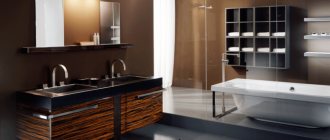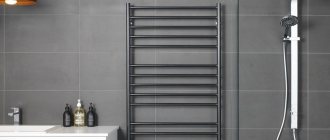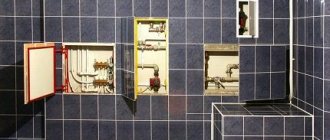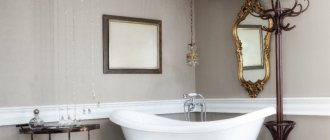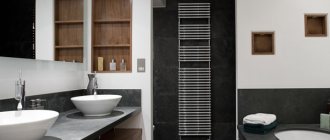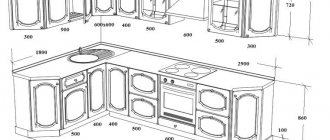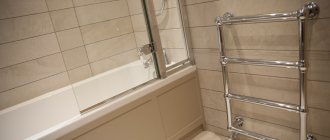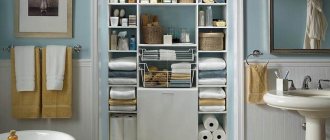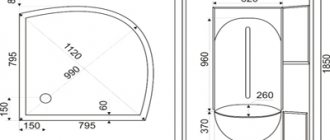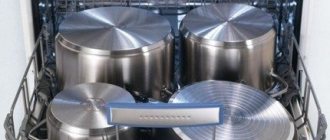Modern man strives for comfort and convenience in all the details that surround him in everyday life. In addition, not only the functionality of individual items, but also their style, which must fit into the overall concept of the room, is becoming increasingly important. These points are perfectly illustrated by bathroom sinks. If previously all models offered on the market were created literally according to several common patterns, now the choice of sinks is so diverse that it allows you to find a solution for bathrooms of any size and even the most original style. However, navigating such a wide range can be very difficult for the average buyer. Even before going to the store, you should figure out what types, shapes and materials of sinks are offered by modern manufacturers, what to look for when choosing, etc. Our article aims to find the answer to all these questions.
Shell shapes
The modern range of plumbing manufacturers offers a wide variety of shape options, but there are several generally accepted options that account for the lion’s share of demand:
- Oval or round - a universal option for any interior style. They look aesthetically pleasing, ergonomic and easy to use. The absence of corners where dirt traditionally accumulates makes them easier to maintain. In addition, sinks of this shape make more efficient use of the available space.
- Rectangular, including square ones, fit organically into modern design concepts. Suitable for spacious bathrooms.
- Semicircular - combines the ease of use of round and oval models and ease of installation - the flat back surface fits flush with the wall, leaving no voids.
- Corner ones are a popular solution among owners of bathrooms of modest dimensions.
Also on sale you can find models of a variety of non-standard shapes that are created for designer interiors.
Types of bath sinks by installation type
This plumbing, depending on the specific model, can be installed in a variety of ways. You should choose one option or another taking into account the dimensions of your bathroom, the location of water pipes and connection points in it, the desired space layout, etc.
Hanging models
The classic version, which is attached directly to the wall using brackets. Such models are made in straight or angular shape. They are well suited to compact bathrooms, since the space under the sink remains empty - this creates visual space. A special type of wall-hung models is the water lily sink, mounted above the washing machine. This placement determines the shallow depth of the bowl and the original design of the water drainage system.
Pros of wall-hung sinks:
- easy installation;
- strong fastening;
- ease of access to the siphon and pipes.
The disadvantages include not the most attractive type of open communications, which a bedside table placed under the sink will help you get rid of.
Models with pedestal
The key difference between these options and wall-mounted products is that they are mounted not to the wall, but to a special pedestal, which, as a rule, comes complete with the sink. This is a vertical earthenware column that is mounted near the wall, hiding a branch of the water supply system.
Such models can be:
- monolithic or separate;
- straight or angular.
A special variety is washbasins with a semi-pedestal. This base does not go down to the floor, but is fixed on the wall. Models of this variety can be chosen if the communications in the bathtub come out of the wall high enough above the floor.
The advantages of pedestal-type models include:
- possibility of use in a variety of design concepts;
- a wide selection of models of various sizes, shapes and designs;
- effective camouflage of pipes without cluttering the space;
- ease of installation;
- democratic price.
The disadvantages in most cases are individual and depend on the material of manufacture and design features.
Wall-hung sink Standard, 56 cm
Overhead sinks
This type of construction involves installing plumbing fixtures on one or another horizontal plane. This can be the top cover of the cabinet or a specially mounted structure. The overhead model can be located on almost any part of the surface - this facilitates the ergonomic organization of the internal space of the bathroom. In addition, you can choose a washbasin of almost any shape - round, oval, rectangular.
The advantages of the overhead type include:
- rational use of free space;
- freedom to choose a place to place the sink;
- ease of installation and connection - only small holes are cut in the base surface for supplying and discharging water;
- Stylish look – a sink bowl placed on a countertop or cabinet will look attractive and original.
Such models have only one significant disadvantage - high cost.
Countertop washbasin CERSANIT Gamma, 63 cm, oval
Built-in sinks
These models differ from the previous type in that they are not installed on the base surface, but cut into it. To do this, you need to make an exact hole, so it will be easier to buy a drop-in sink, which already comes with a suitable cabinet.
In this case, the bowl can be immersed in the thickness of the stand either completely, without protruding above its surface, or partially. Its shape can be different, the most common are rectangular and oval options. A common option is sinks with sides that rest on the base.
The advantages of washbasins of this type include the following:
- ergonomics;
- the ability to store household supplies under the sink;
- there is no need to drill into the wall - the sink is completely attached to a horizontal plane;
- protection from damage;
- effective camouflage of communications;
- attractive, elegant look.
The disadvantage of mortise sinks is their relatively bulky size. Therefore, this option is not suitable for small bathrooms.
Built-in washbasin CERAMIN Turin, 56 cm, oval
Types of sinks by material of manufacture
Important parameters of plumbing fixtures such as strength, service life and appearance depend on what type the manufacturer has chosen. Therefore, when choosing, you need to take into account both the style of the bathroom and the operating conditions - not separately, but together. In addition, the cost of the sink depends on the material - and for models of identical sizes and shapes it can differ significantly.
Faience is a classic option that is not losing popularity
This material is most often used for sinks installed in bathrooms. The material is based on clay, the characteristics of which are modified by various additives. After giving the required shape, the workpiece is sent to a special oven, where it acquires high strength. After this, the surface of the future sink is covered with glaze, which closes the pores in the base material and further increases the strength of the product.
Key advantages of using earthenware:
- affordable price;
- the ability to create shells of various shapes;
- wide tinting possibilities;
- ease of care.
Earthenware sinks look decent and have an attractive glossy surface. However, they are quite fragile and are afraid of impacts. From them, the surface of the earthenware becomes covered with cracks and chips, and if the blow was strong enough, the plumbing fixtures may break completely.
Another significant drawback of earthenware models is the accumulation of dirt. The glaze closes most of the pores remaining after heat treatment, but those that remain open actively trap dirt. Therefore, earthenware requires quite frequent and intensive cleaning.
Countertop washbasin GUSTAVSBERG Nautic, 45 cm, oval
Porcelain is a more elegant relative of faience
The production technology for such sinks is almost identical to earthenware models: a product of the desired shape is formed from raw material, then the workpiece is baked, glazed and decorated. The key difference is the different composition and properties of the raw materials, thanks to which porcelain washbasins have the following advantages:
- spectacular appearance;
- smoother surface;
- high density, less tendency to accumulate dirt - therefore easier to maintain;
- durability with careful use.
The last point reflects one of the key disadvantages of porcelain sinks - they are stronger than their earthenware counterparts, but they are still susceptible to strong impacts. In addition, such models are heavier, which not only complicates their installation, but also requires more reliable fasteners. And porcelain is significantly more expensive.
Metal Bathroom Sinks
In interiors decorated in high-tech, techno and similar styles, washbasins made of special grade stainless steel will look most organic. The raw materials used for them usually include chromium and nickel, which not only increase the alloy’s resistance to corrosion, but also give it a special shade, darker and deeper than the color of ordinary stainless steel. An additional artistic effect is given to such sinks by the metallic shine of the surface.
The main advantages of steel models include the following properties:
- rust resistance;
- high mechanical strength;
- immunity to the effects of caustic substances;
- absolute waterproofness and hygroscopicity;
- ease of care;
- the ability to manufacture sinks in any size and shape;
- durability.
However, such models are not without some disadvantages. First of all, this is their noise - if high-quality sound insulation is not provided, the flow of water falling into the sink will create a characteristic roar. In addition, if the water in your bathroom is fairly hard, traces of mineral deposits will regularly appear on the metal surface. Such a sink can only be cleaned with soft liquid or gel-like products - abrasive powders will scratch the metal, spoiling the appearance of your plumbing fixtures. In addition, steel models are not suitable for all interior styles.
Natural stone as a material for a sink
Such models look very impressive; the natural pattern of stone - granite, marble or other rocks - gives them special beauty. Some of them, for example, onyx, partially transmit light, thanks to which the sink acquires a unique flavor.
The general advantages of stone plumbing are:
- environmental safety and cleanliness (ask the seller for the appropriate certificate);
- impressive durability;
- resistance to a wide range of temperature changes;
- ease of cleaning and maintenance;
- immunity to mold and other fungi.
At the same time, the stone is not strong enough - strong impacts can leave scratches and even chips on its surface. Only a fairly labor-intensive restoration can return it to its original appearance. And stone sinks are very heavy and expensive.
Artificial stone is a worthy alternative to natural rocks
There are a wide variety of sinks on the market made from a special acrylic mixture with a mineral filler, which in terms of external qualities and strength are practically indistinguishable from natural stone. However, the synthetic substitute has many advantages over natural material:
- significantly less weight;
- easier installation;
- the ability to adjust the shape and size of the sink to the installation site.
At the same time, acrylic-based material is no less wear-resistant, safe and hygienic. And the price of a sink made of artificial stone is significantly lower.
The main disadvantage of such models is less resistance to high temperatures, which can cause unsightly stains to appear on the surface of the material. It also scratches easily - however, such defects can be removed quickly enough even without dismantling.
Washing machine sink Buta 60, 61x60.5 cm
Glass Bathroom Sinks
Such models are made from high-strength glass, tempered using a special technology. The original properties of the material and manufacturing technology provide glass sinks with a wide range of advantages:
- strength is higher than that of earthenware and porcelain models;
- immunity to wide ranges of temperature changes;
- inertness to aggressive substances;
- perfectly smooth surface;
- hygroscopicity and waterproofness;
- possibility of execution of any forms;
- unlimited tinting possibilities.
Of course, only models from reputable manufacturers have all these properties. Therefore, when choosing a glass sink for the bathroom, you should not chase a low price - high-quality models are quite expensive.
At the same time, any glass washbasins have a common drawback - they become covered with stains almost after every use. Therefore, they have to be constantly wiped dry.
Fake diamond
Such a sink will have less weight and lower cost, while outwardly it will look like natural stone.
Pictured: SP Concept integrated washbasin from Porcelanosa Grupo.
Artificial stone is the best option for customers who like stone washbasins, but due to financial restrictions they cannot afford it.
Pros:
- Beautiful appearance, close to natural stone.
- Lower price compared to natural stone.
- Less weight.
- A variety of shapes and colors, for example, you can make the countertop and sink the same color.
- High resistance to dirt, high temperatures, and mechanical stress.
- Highly silent sink, compared to metal: flowing water from the tap does not make clanging sounds.
- You can use any cleaning products, but preferably without abrasives; creamy cleaning gels work well.
- The possibility of restoring cracks using a composite composition and grinding at home.
Almond washbasin from Porcelanosa Group.
Minuses:
- Higher price compared to earthenware or metal.
- Over time, traces of dirt may appear, especially on light-colored surfaces.
- It has significant weight compared to metal.
- If dropped, it can break or crack; in terms of durability, it is inferior to metal.
- 1 of 4
On the picture:
What else to look for when choosing
To choose a truly high-quality, beautiful and practical sink, you should also consider a number of the following features:
- color – white models would be a universal solution, but you can emphasize the individuality of the interior with a model in a different color;
- protective coating – models from well-known manufacturers have a special coating that prevents the accumulation of dirt and the appearance of plaque, this makes cleaning the sink much easier;
- hole for installing a mixer - a number of models assume its placement directly on the washbasin, while others are suitable for those cases. when the mixer is mounted on the wall (depending on the location of the water supplies);
- overflow protection - in the upper part of the bowl there may be a hole to drain excess water, it will prevent overflowing over the edges, however, its use will require an additional flexible supply connected to the water drainage system;
- execution style - the sink must be combined with the overall design concept of the interior; for this you need to choose the right shape, size, material and color;
- brand - it is better to give preference to products from well-known and reputable manufacturers, which is a guarantee of quality.
Of course, for each bathroom the sink must be selected individually, taking into account its size, nature of use, style, etc. Our article will help you understand the proposed options, in which we examined the key selection criteria and types of washbasins for bathrooms.
Metal
The washbasin can be made of stainless steel - this is the most common option, as well as copper, bronze, brass, and cast iron. In appearance, stainless steel goes well with chrome-plated plumbing fixtures, and the affordable price attracts buyers.
Pictured: De Coste sink from Glass Design.
Distinctive features of metal sinks are high strength and long service life.
Pros:
- High performance and durability, maximum damage is scratches.
- Resistance to high temperatures.
- Can be washed with any detergent, but without abrasive so as not to scratch the surface.
- Resistant to contamination from coloring liquids such as red wine, coffee or iodine.
- The product is light in weight, which is undoubtedly convenient both during transportation and installation.
- When drilling technological holes in a washbasin, there is no danger of splitting the surface, compared to stone, ceramics, and glass.
- Affordable price.
Minuses:
- Higher sink noise when compared, for example, with stone or ceramics.
- Over time, scratches may appear, especially if used carelessly.
- It is advisable not to use abrasive detergents to avoid scratches.
- 1 of 4
